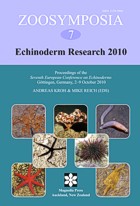Abstract
Based on the main feeding modes of two common European brittlestars, Ophiothrix fragilis and Ophiura albida, the present study relates the species’ tooth morphology to their function in processing food items of different structural quality. Clusters of grinding dental papillae in the suspension feeding O. fragilis seem most appropriate for loosening compound food items, i.e., food boli, or potentially for grazing. Large triangular teeth are considered to be used as crushing and cutting instruments, most likely for processing loosened or broken up food masses into smaller digestible portions. In the mostly predating and scavenging O. albida, sharp and pointy or broad scale-like oral papillae may serve in gripping and fixing live benthic prey organisms or carrion, while the larger spine-like teeth may be applied as carnassial instruments thrusting into the flesh of a prey organism and tearing off pieces. Designating the two species either as grinders and cutters processing compound and hard structured food or as grippers and tearers handling softer textures, still awaits confirmation through feeding experiments and observational documentation.

